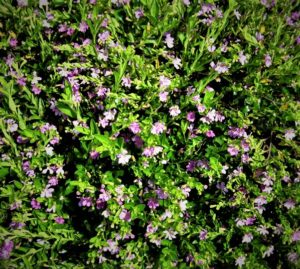Mexican heather makes Texas Superstar list
Versatile pollinator-friendly ornamental
Mexican heather, an old-fashioned and reliable pollinator-friendly ornamental plant that adds big color to gardens and landscapes has been named the latest Texas Superstar.
David Rodriguez, Texas A&M AgriLife Extension Service horticulturist, San Antonio, said Mexican heather has been a favorite ornamental plant in Texas gardens for many years. Mexican heather plants are also a top attractor for pollinators like bees and butterflies.

One of the standout Mexican heathers is Allyson, an improved variety with showy flowers and compact size, Rodriguez said. It has performed beyond other varieties.
To be designated a Texas Superstar, a plant must be beautiful and perform well for growers throughout the state. Texas Superstars must also be easy to propagate, ensuring the plants are widely available and reasonably priced.
“Mexican heather is a good plant that has been around for years, and sometimes a tried and true plant is taken for granted and gets overlooked,” he said. “It’s surprising we’re just now recognizing its reliability and overall performance as a very versatile ornamental. But Mexican heather is like an ace card that we’ve kept in the hole.”
Mexican heather varieties
Mexican heather, also referred to as false heather, is a multi-stemmed annual with an upright, spreading growth habit.
Many varieties are on the market, including the Myrto series, which includes selections with purple, pink or white flowers.
The Allyson variety produces an abundance of petite rose-purple flowers from spring to the first hard frost. Its medium texture blends well into the garden and can always be complimented by a couple of finer or coarser plants for an effective configuration, Rodriguez said.
“The shape of the plant layers out with tiny leaves and flowers, but when it blooms there are so many flowers it covers the foliage, which if you can see it, has a sheen to it,” he said. “The flower color and foliage sheen give the plant a very good presence in most any planting situation.”
Mexican heather are best used as mass bedding, in mixed borders, mixed containers, butterfly and/or pollinator gardens or as stand-alone patio specimens and hanging baskets, Rodriguez said.
Plants benefit from mulching and regular summer irrigation but do not tolerate standing water. They grow and bloom best in full sun, but late afternoon summer shade is preferred, Rodriguez said.
The Allyson variety grows 12-18 inches tall and 16-18 inches wide, he said.
They perform best as a seasonal annual, especially from late spring to the first frost, Rodriguez said. However, they often re-sprout late in the following spring after a mild winter in South Texas.
But new spring plantings always outperform carry over plants, he said.
Maximize and maintain
Plants are readily available spring through summer. They start with 4.5 inch or quart size containers progressing later in the season to larger 10-inch hanging baskets and patio specimens.
For landscape plantings, amend native soils with liberal amounts of a landscape mix containing finished compost, Rodriguez said. Container specimens should be grown with a peat-based premium potting mix that is cut with about 20% finished compost.
Incorporating copious amounts of an appropriate slow-release fertilizer at the time of planting will help ensure vigorous growth and maximize flowering. Supplementing with a water-soluble fertilizer every 10-14 days throughout the growing season is also beneficial.
Rodriguez said newly planted Mexican heather should receive extra waterings until well established.
“There are other common selections of Mexican heather that are great plants, and I encourage gardeners to experiment with combinations, but we think Allyson is the best performing variety at this time,” he said. “It’s perfect for all sorts of plantings and works in all the criteria we look for in a Texas Superstar, including its role as an attractor of beneficial insects and pollinators.”
Texas Superstar is a registered trademark owned by Texas A&M AgriLife Research, a state agency that is part of the Texas A&M University System. Plants are designated Texas Superstars by the Texas Superstar executive board, which is made up of nine horticulturalists from AgriLife Research, AgriLife Extension and Texas Tech University.


